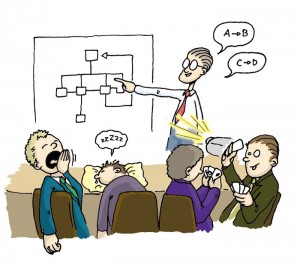Opening a Presentation
Tell a Story

Here’s the amazing thing about stories: If your presentation is based solely on facts and stats then you
r audience is going to react in one of two ways: 1) agree or 2) disagree. However, if you tell a story, your audience will participate with you.
Point to the Future or Past
-Prospective (looking to the future): “30 Years from now, your job won’t exist.”
-Retrospective (looking to the past): “In 1970, Japan owned 9% of the market. Today, they own 37%.”
The reality is that looking into the future or past always sparks engagement since that’s where our hearts live.
Share Something Extraordinary
I don’t know about you, but I love Snapple. Even more so, I love their bottle caps since they always share fun facts or extraordinary insight into ordinary things. Is my life going to be improved because I know how many times a hummingbird’s wings flaps in a second? No. Is it crazy interesting? Yes.
Closing
Circle Back Around
One of the best ways to make sure your message gets across is to come full circle with your presentation and help tie things together.
Repeat the Important Stuff
Presentations are all about brevity, levity and repetition. If you are making a handful of significant points throughout your talk, use your ending to remind your audience of those items.
Call to Action or Inspire
Have you seen one too many presentations where the presenter never invites the audience to do something with the new information that was just presented? Audiences are always thinking – “What’s the next step?” Download a PDF? Buy a book? Contact someone? The audience has just invested 30, 60, or 90 minutes looking for a value-add, so make sure you provide purpose to your talk by creating a compelling call to action.
Leave a Reply
You must be logged in to post a comment.